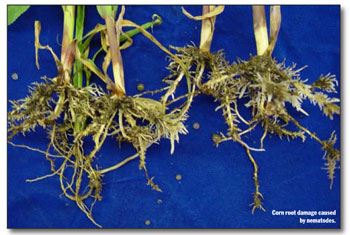Looking Below The Surface: Do You Have A Corn Nematode Problem?
URBANA, ILL.
Is there a problem with corn
nematodes in your crop? Is
your use of a nematicide
doing any good? Let’s review
some guidelines.
Unthrifty corn. Corn not
looking so hot? Rather than a
herbicide, nutrient, or environmental
issue, unexplained
yield losses or patchy areas of low productivity
or vigor may indicate an established corn nematode
population. An extensive survey in 2009-
2010 supported by our University of Illinois
NIFA-Extension IPM program showed that corn
nematode populations are a bigger problem that
previously thought.
The survey found, for example, that about half
of the cornfields in Illinois have lesion nematode
populations with densities at or above the
threshold for moderate to severe risk of injury
(yield loss). Not only can lesion nematodes injure
corn roots, but they frequently act as vectors
for the development of root rots. The
common belief that corn nematodes are important
only in very sandy soils is not accurate.
Sandy soil is a risk factor for only a few species
(needle, sting, and stubby-root nematodes
throughout Illinois, and southern root-knot
nematode in southern Illinois). Although needle
nematode can kill corn seedlings, most nematodes
will not cause injury that severe unless
the infestation level is very high.

Corn nematodes include a number of damaging
species, such as dagger, lance, lesion, ring,
stunt, and occasionally spiral nematode, which
may be found in heavy soils. While many companies
produce chemicals to manage corn nematode,
it is still important to check the product
use indications before applying them. Different
nematode situations require different types of
product application, so it is best that you send
in a sample for analysis before attempting nematode
control. You have no other way of knowing
the identification of your initial population
or whether is being controlled.
Sampling for diagnosis. Consider sampling
for nematodes now, especially in cornfields that
are at risk. Risk factors include corn-on-corn
growing, minimal or no tillage, and the absence
of nematode-suppressing soil-applied insecticides.
Although the best time to sample for
nematode diagnosis is about 4 to 6 weeks after
planting, a couple of weeks more or less may
not matter very much.
How and where you sample are determined by
the reason you’re sampling. Corn nematode
management is determined by the species involved
and how high their numbers are, so it is
very important to get a good sample for a reliable
diagnosis. Typically you just want to know
whether nematodes are the cause of yield loss in
a given field. You can start by examining the
physical characteristics of the plants:
• If there are no symptoms, focus sampling on
a representative area of the field, perhaps 10
acres or less. Nematodes can reduce yields
without causing obvious symptoms. Record the
GPS coordinates for the area. Sample in a zigzag
or W-shaped pattern, and collect 20 to 25 cores
in a bucket.
• If there are symptoms (“hot spots”), sample
around the edges of symptomatic areas, collecting
a total of 20 to 25 cores. Record the GPS coordinates
for the area.
Keep these guidelines in mind as well during
sampling:
• Sample as deeply as possible from within the
rows when the soil is moist but not wet at least
6 to 8 inches. Use a 1-inch-diameter soil probe
if possible.
• Treat the samples gently at all times – do not
drop them or break up the cores. Some corn nematodes
are very sensitive to manipulation, and
you want to avoid killing them before they reach
the lab.
• Put the sample in a plastic bag – not paper –
to help preserve moisture during transport.
Take a cooler along to store the samples and
keep the nematodes from being cooked!
• Include the GPS coordinates for the samples
along with your contact information when you
submit samples.
• Sample around the edges of the hot spots in
the field, not in the centers.
Diagnosis. Corn injury caused by nematodes
cannot be diagnosed from symptoms alone. The
symptoms of nematode parasitism look similar
to those caused by other production problems,
including poor or uneven crop development, yellowing
or streaking, and reduced or brushy root
systems. The only way to diagnose corn nematodes
is to directly examine them under a microscope
following an appropriate extraction
method. Some private labs analyze soil for corn
nematodes, as will the University of Illinois
Plant Clinic.
The former nematology testing lab has merged
with the Plant Clinic, and nematologist Dr. Alison
Colgrove and her staff manage testing and
analysis. Services include soil nematode analysis
($40), root analysis ($40), soybean cyst nematode
(SCN) egg counts ($20), and pinewood
nematode analysis ($20). Send your samples to
the Plant Clinic; you can get more information
on sample submission at our website. For specialty
testing, including SCN Hg typing, variety
screening, phytosanitary testing, and other
nematode projects and diagnostics, contact Dr.
Colgrove before sending any samples: acolgrov@illinois.edu, 217-333-9057. Δ
DR. SUZANNE BISSONNETTE: Plant Diagnostic
Clinic and IPM Coordinator, University of Illinois